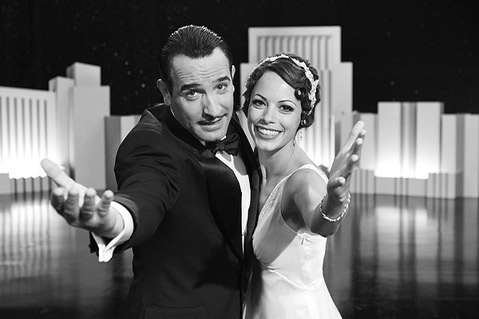The Artist
Jean Dujardin, John Goodman, and Bérénice Bejoand star in a film written and directed by Michel Hazanavicius.

Part of what makes The Artist such a fascinating curio among this year’s top crop of films is the sense of what it proudly and assuredly is not. At a time when 3-D technology, cheap gizmos, and novelties and recycled yarns and sequels are being pumped out of the Hollywood machine, here we have a contemporary silent film (apart from select, key moments, which the critic’s creed prevents us from revealing).
In terms both vintage and post-Modern, French director Michel Hazanavicius’ compelling film pays deep respects to the history of cinema, especially that vulnerable moment when the silent format morphed into the “talkies,” while telling an engaging story. Enhanced greatly by the involving and emotionally-encoded orchestral score by Ludovic Bource, and hyper-sensitive cinematography by Guillaume Schiffman, The Artist is certainly one of the more visually-powered films in theaters of late.
In the lead role, rightfully lauded actor Jean Dujardin loops around between natural expressiveness and a mannered hamminess in his performance as a self-absorbed and dashing silent era star, George Valentin, poised for a fall between the “talkies” and the big crash. By way of dismissing the star from the studio roster, the director (played by John Goodman) tells our protagonist, “The world is talking now.” Representing the new, sound-fortified world is fast-rising star Penny Miller (Bérénice Bejo), who maintains a quasi-romantic and compassionate connection to the veteran star.
In its way, the premise is campy and maudlin, like many of the silent-era films, and liberally strewn with retro iris shot transitions between scenes. But there are aesthetic forces at work all along the way, right through to the film’s last word: “Action!” That the film coyly operates on multiple layers and levels of meaning is clear from the opening sequence, a film-within-a-film-within-a-1927 movie house, in which that film’s star views his work in reverse from behind the screen. In this great stage-setting scene, the perceptive flip-flops are dizzying and delicious.
In the end, somehow, The Artist manages to be arty and emo at the same time, a confirmation of cinema’s primal sensory power sources — sight and motion — and a sweet little tragic romance yarn, gently squeezed through the happy ending machine. From another angle, it’s an abidingly artful valentine to the bygone legacy of this profoundly influential art form, whose root system we too easily take for granted. Leave it to the cineaste French to pull of such a feat.



